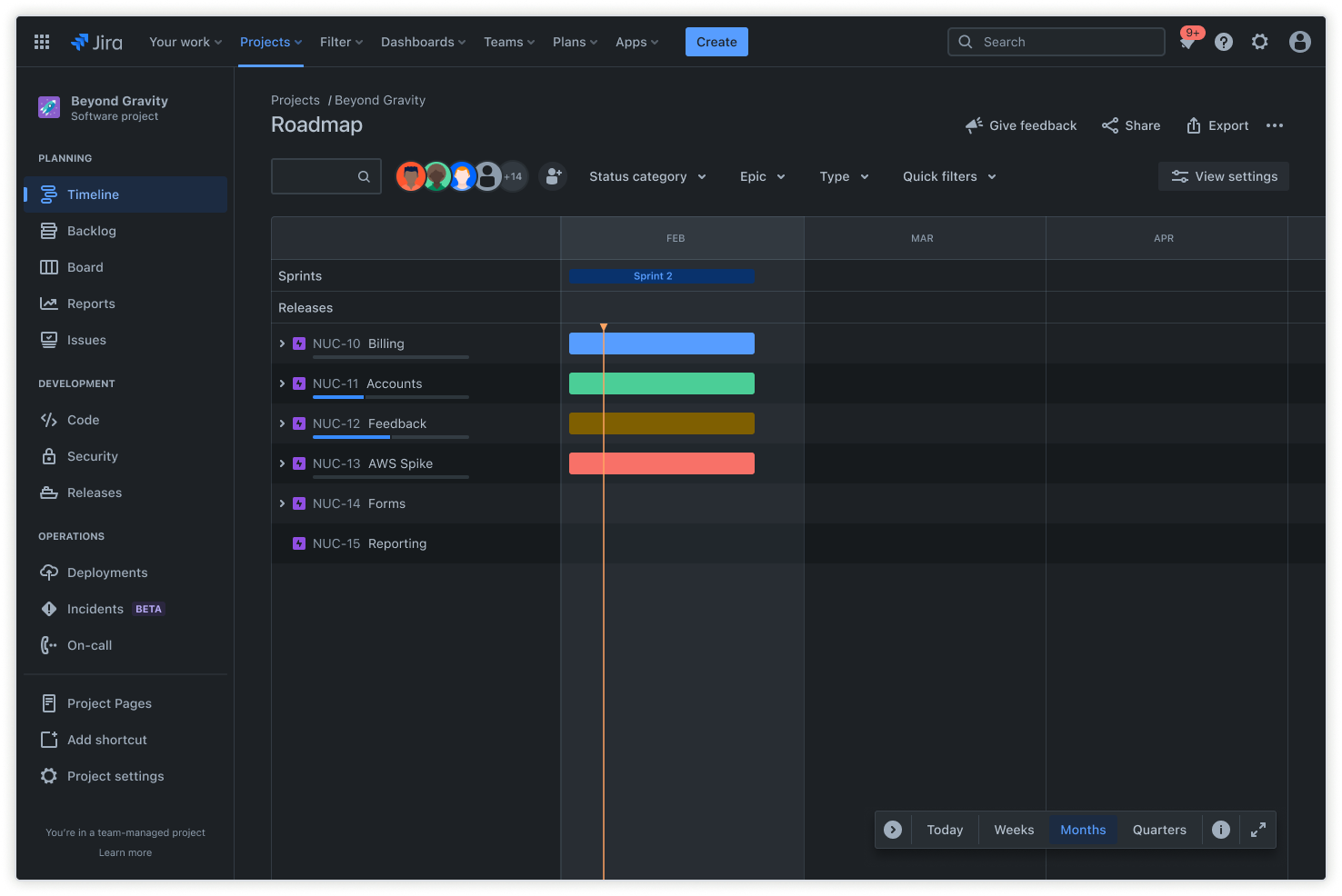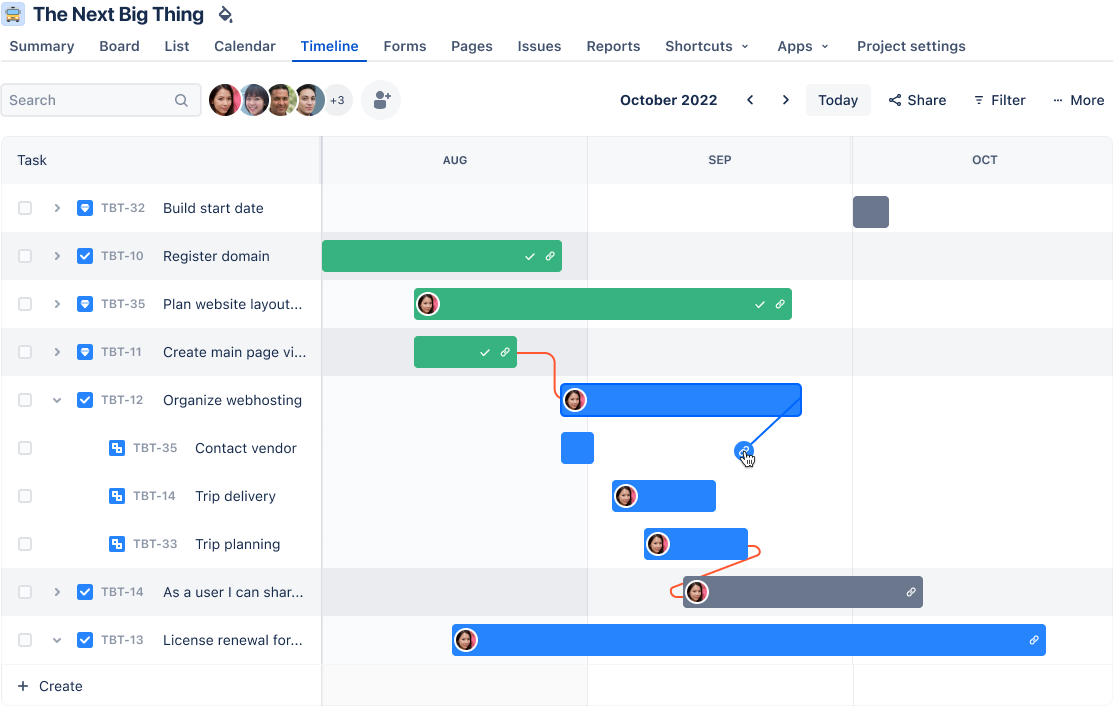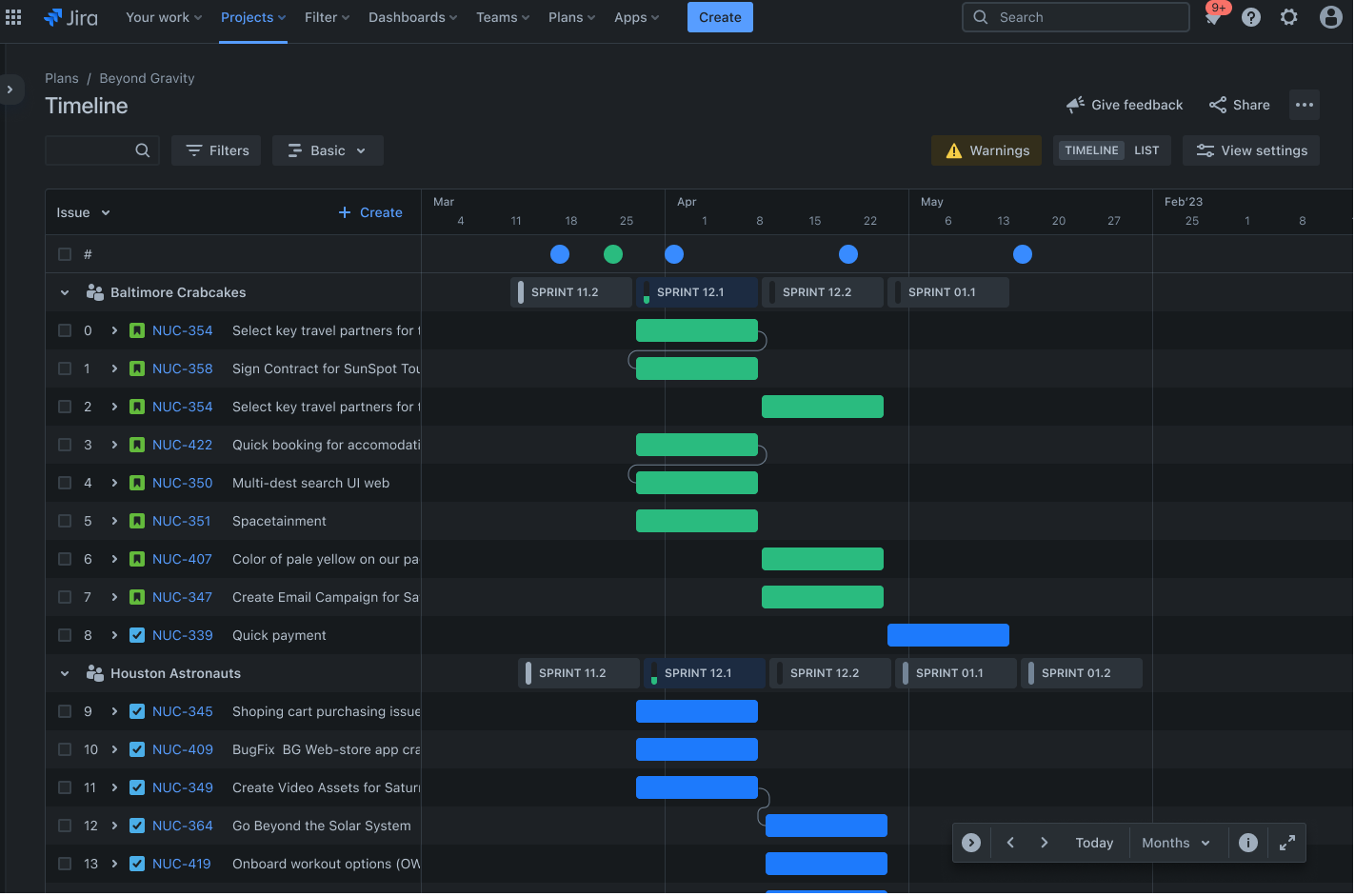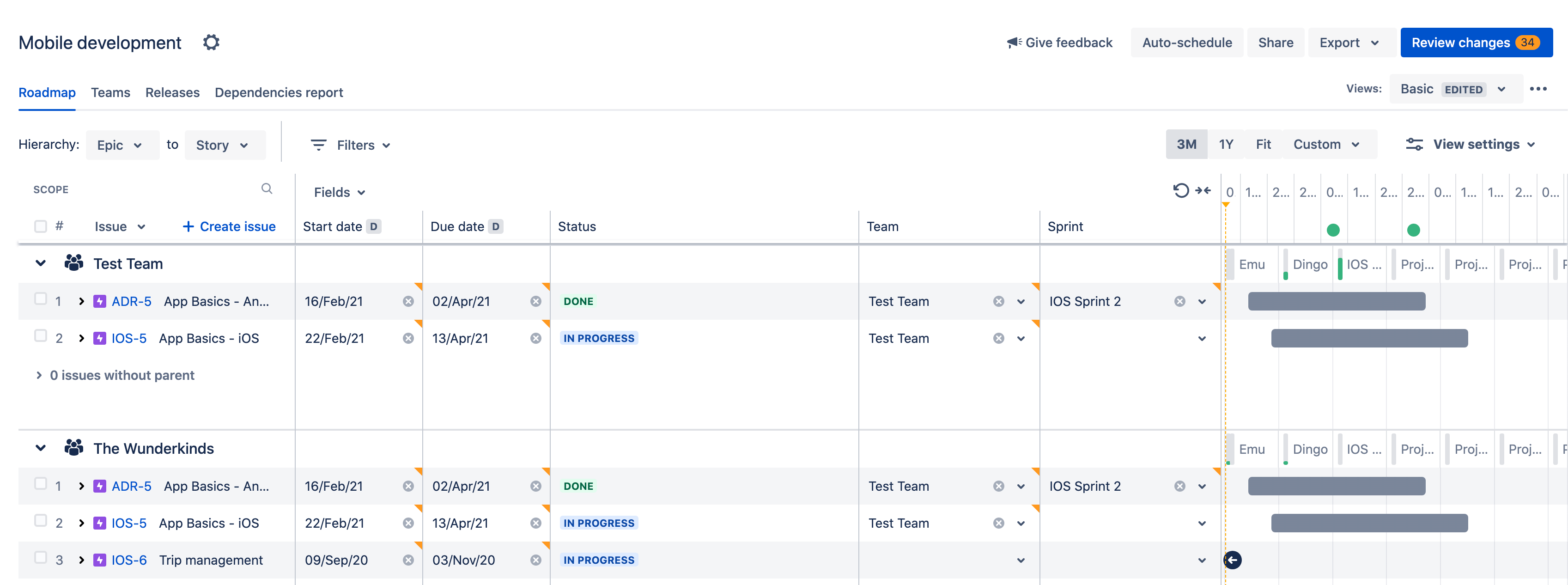Summary: A Gantt chart is a visual timeline for tracking tasks and milestones throughout a project's lifecycle. It offers a high-level overview of project schedules, making it easier to manage complex plans involving multiple teams and shifting deadlines. By providing clear visibility, Gantt charts empower project managers and teams to stay organized and focused on achieving their goals together.
Whether you're managing sprints or long-term projects, this comprehensive guide explores what Gantt charts are, their practical applications, and the many benefits they offer.
ガント チャートとは?
A Gantt chart is an agile project management tool used to plan and track the progress of various tasks and activities within a project. Serving as a visual timeline, it displays the list of tasks, their start and end dates, milestones, dependencies between tasks, and assignees.
As a valuable roadmap, a Gantt chart guides teams and organizations in effectively planning and coordinating their work items. By illustrating task interconnections, it fosters seamless collaboration and alignment among project stakeholders, ensuring everyone is on the same page and working towards the same goal.
ガント チャートを使用するメリット
ガント チャートには主に 2 つのメリットがあります。
Simplifies complex planning
Gantt charts make it easier to create complex plans, particularly those involving multiple teams and shifting deadlines. They also help teams schedule tasks around deadlines and allocate resources efficiently.
Enhances task scheduling and resource allocation
Project planners rely on Gantt charts for a high-level overview, showing key details like task start and end dates, milestones, and dependencies. Modern Gantt chart programs like Jira Timelines and Jira's Advanced Planning synthesize information and illustrate how choices impact deadlines.
Gantt chart components
Gantt charts typically include two sections; the left side outlines a list of tasks, while the right side shows a project timeline with schedule bars that visualize work. Let's take a closer look at the primary components to look for in a Gantt chart.
タスク リスト

A task list is a comprehensive list of all tasks required to complete the project. In Jira, tasks can be created and managed using the issue tracker, which allows you to assign tasks to team members, set priorities, and track progress. This ensures that every team member knows their responsibilities and deadlines, promoting accountability and efficiency. For example, a software development team uses the task list to assign coding, testing, and deployment tasks to different developers, ensuring a smooth workflow.
タイムライン

The timeline is a visual representation of the project schedule, showing start and end dates at the top of the chart. Jira's Timeline feature provides a clear view of your project schedule, helping you visualize the sequence of tasks and their durations. Timelines help identify potential bottlenecks and allow for proactive adjustments to keep the project on track. For example, a marketing team uses the timeline to plan a product launch, ensuring all promotional activities are aligned and executed on time.
依存関係

Links between tasks dictate the order of operations and show how tasks are related. Jira's Advanced Roadmaps allows you to set dependencies between tasks, ensuring that tasks are completed in the correct order and automatically adjusting schedules when changes occur. This prevents delays by ensuring that prerequisite tasks are completed before dependent tasks begin. In a construction project, for example, dependencies ensure that foundation work is completed before building the structure.
マイルストーン

Project milestones on Gantt charts are markers on the project timeline indicating major progress or completion of project phases. In Jira, you can mark key milestones using milestone markers, which help keep your team focused on critical deadlines and achievements. Milestones provide motivation and a sense of accomplishment, helping teams stay focused on long-term goals. A product development team sets a milestone for completing the prototype phase, signaling readiness for user testing.
ガント チャートの使用目的
プロジェクト マネージャーは、主に次の 3 つの理由でガント チャートを使用します。
包括的なプロジェクトを構築して管理する
ガント チャートでは、プロジェクトの構成要素を視覚化して、プロジェクトを管理できるくらいの小さなタスクに分割します。分割されたタスクは、タスク間の依存関係、担当者、マイルストーンとともに、ガント チャートのタイムライン上に配置されます。
全体の流れとタスク間の依存関係を特定する
ガント チャートを使って、プロジェクトの流れを監視します。タスクの依存関係のため、別のタスクが終了してからでないと新しいタスクは開始できません。タスクが遅延した場合、自動的に再スケジュールされます。これは、複数チーム環境で計画を立てる場合に特に役立ちます。
プロジェクトの進捗を監視する
チームが計画内の作業項目に対処するのに要した時間を記録すると、プロジェクトの健全性を監視して、必要に応じて調整できるようになります。ガント チャートには、リリース日、マイルストーン、またはプロジェクトの進捗を追跡するためのその他の重要なメトリックを含められます。
ガント チャートの作成方法
ガント チャートのメリットを念頭に置いて、プロジェクト計画を明確で実行可能なチャートに変換する方法を詳しく見ていきます。ガント チャートがプロジェクトを成功させるための貴重なツールになるように、プロジェクトのスコープの定義から進捗の追跡まで、重要なステップについて説明します。
Step 1: Define the project scope
ガント チャートを作成する最初のステップは、プロジェクトのスコープを定義することです。まず、プロジェクトの主な目標を特定します。明確な目標がプロジェクトの指針となり、プロジェクトのライフサイクルを通じてすべてのタスクがこれらの目的と確実に一致するようになります。
目標を定義したら、主な成果物の概要を記述します。これらは、プロジェクト全体を通して生み出す必要のある具体的な成果になります。
Step 2: List all tasks and subtasks
次に、各成果物を完成させるために必要なすべてのタスクをリストします。チームが何をすべきかを明確に示すために、大きなタスクを小さなサブタスクに分けます。各タスク、担当チーム メンバー、必要なリソースを特定します。
Step 3: Estimate task duration
各タスクが完了するまでにかかる時間を割り出します。現実的に考えて、潜在的な遅延を考慮してください。予期しない遅延に対応し、プロジェクトが順調に進むように、予定にバッファー時間を含めます。
Step 4: Determine task dependencies
タスクの順序を指定します。タスクの中には、他のタスクが終了した後にしか開始できないものがあります。タスク間の関係を定義するには、終了 - 開始型、開始 - 開始型のような依存関係タイプを使います。
Step 5: Choose a Gantt chart tool
ガント チャート ツールを選ぶときは、いくつかの要素を検討して、ツールがプロジェクトのニーズを満たしているかどうかを確認します。
Jira is an excellent option for creating Gantt charts, particularly for software development teams. Tools such as Timelines and Plans help you create advanced roadmaps. These features support detailed task management, dependency tracking, and resource allocation. You can even use a Gantt chart template to streamline the process.
Step 6: Input data
すべての情報を入手したら、選択したツールにデータを入力します。すべてのタスクとそれに対応する期間をガント チャートに入力します。順序を明確にするために、タスク間の依存関係を設定します。プロジェクト タイムラインの重要なポイントを強調するために、重要なマイルストーンを含めます。
効果的なガント チャートを作成するためのベスト プラクティス
データを入力するだけでは効果的なガント チャートは作成されません。ここでは、従うべきベスト プラクティスをいくつかご紹介します。
- シンプルかつ明確に。ガント チャートに情報を詰め込みすぎないようにします。色とラベルは控えめにし、最も重要なタスクと依存関係だけを含めます。
- 色分けを使う。色分けは、さまざまなタスク タイプや段階をわかりやすく視覚化するのに役立ちます。これにより、タイムライン ビューが改善され、進捗を一目で追跡しやすくなります。
- 明確にコミュニケーションを取る。明確なタスクの説明、マイルストーン マーカー、依存関係タイプを使って、すべてのチーム メンバーがガントチャートを理解できるようにします。これは混乱を避け、間違いを防ぐのに役立ちます。
- チーム メンバーや関係者と共有する。ガント チャートをすべての関係者と共有して、チーム全体の意思統一を図ります。ガント チャートのアップデートや変更についての最新情報を全員に伝えます。
- チャートは定期的にアップデートする。ガント チャートは、プロジェクト全体を通して定期的にアップデートされる、生きたドキュメントにする必要があります。対応する変更を加えて、完了したタスクや遅延したタスクでタイムラインを正確に保ちます。
-
フィードバックを取り入れる。チームに定期的にフィードバックを求め、それをガント チャートに組み込んで、正確さと効果を高めます。
How different stakeholders utilize Gantt charts
Gantt charts are versatile tools that cater to the diverse needs of various stakeholders within a project team. Here's how different roles utilize Gantt charts, the components they focus on, the questions they aim to answer, and the common challenges they face:
プロジェクトマネージャー
Project managers use Gantt charts to oversee the entire project timeline, manage resources, and ensure deadlines are met.
Key questions: "Are we on track to meet our deadlines?" "What resources are needed at each phase?" "How do task dependencies affect the project timeline?"
Common challenges: As a project manager, juggling complex dependencies and resource allocation can be tricky. Jira's Advanced Roadmaps feature helps by automatically adjusting schedules when dependencies change and providing a clear view of resource allocation.
チーム メンバー
Team members focus on their specific tasks and dependencies to understand their role in the larger project. They interact most with the task list and timeline components to track their responsibilities and deadlines.
Key questions: "What tasks am I responsible for?" "What are the deadlines for my tasks?" "How do my tasks fit into the overall project?"
Common challenges: Managing tasks and tracking changes and dependencies can be constantly shifting. Jira's real-time collaboration and issue tracker features ensure team members are always updated on task changes or dependencies shifts.
ステークホルダー
Stakeholders view high-level progress and milestones to stay informed about the project's status. They focus on milestones and visual aids to grasp the project's progress quickly.
Key questions: "What is the current status of the project?" "Have we reached key milestones?" "Are there any major risks or delays?"
Common challenges: When trying to understand complex project details, stakeholders can feel easily overwhelmed by information. Jira's customizable views and milestone markers provide stakeholders with a clear, high-level overview of the project, ensuring they are informed without being overwhelmed.
By leveraging Jira's robust features, each stakeholder can effectively use Gantt charts to meet their specific needs, ensuring a cohesive and well-managed project.
Key features of Gantt chart software
Gantt chart software, like Jira, offers advanced features to enhance project management efficiency and effectiveness. Here's why these features are essential:
Automatic scheduling
This feature automatically adjusts timelines when task dependencies change, ensuring your project plan remains accurate and up-to-date. It saves time and reduces the risk of human error, allowing project managers to focus on strategic planning rather than manual updates.
リソース管理
Efficient resource allocation is crucial for project success. Effective resource management features help distribute tasks and resources across teams, optimizing workload and preventing burnout. This ensures that all team members are utilized effectively, contributing to a balanced and productive work environment.
リアルタイム
コラボレーション
With real-time collaboration, team members can update progress and communicate changes instantly. This feature fosters transparency and keeps everyone aligned, reducing miscommunication and enhancing team cohesion. It is particularly beneficial for remote teams or projects with tight deadlines.
Customizable views
Different projects require different perspectives. Jira offers customizable views, such as daily, weekly, or monthly timelines, to suit various planning needs. This flexibility allows project managers to tailor their Gantt charts to specific project requirements, improving clarity and focus.
Integrations and compatibility
Gantt chart tools are most effective when they integrate seamlessly with other project management software and platforms. Jira excels in this area by offering robust integrations with tools like Trello and BigPicture. These integrations enable smooth project management across different systems, enhancing collaboration and efficiency.
By incorporating these features and integrations, Jira is a comprehensive solution for modern project management needs.
Jira でのガント チャートの使用方法
Jira には 2 つの異なるロードマップ機能があり、これらはそれぞれ焦点が若干異なります。Jira のタイムラインは 1 つのチームに割り当てられた作業を追跡するのに対して、プラン機能はより大規模で会社横断的なプロジェクト計画に特化しています。
特定のプロジェクト専用のチャート: Jira タイムライン
下のスクリーンショットはタイムラインから取得したもので、特定のプロジェクト専用のガント チャートを示しています。このチャートは一般的に、チーム レベルで、または単一のグループ内で使用されます。このチャートは、チームが目的に向かってどのように進んでいるかを示しており、折りたたみ可能な作業分解構造によって、プロジェクト マネージャーがプロジェクトの重要なストーリーを俯瞰できるようになります。Jira には、ガント チャートを含む無料のプロジェクト管理テンプレートがあります。

大まかな組織図: プラン機能
Jira のプラン機能は、チームが依存関係をより適切に管理して、全体像の進捗をリアルタイムで追跡するために役立つ、迅速かつ簡単な計画を提供します。これらのプロジェクトまたはチーム レベルのロードマップは、大規模な作業をチーム レベルで計画するときに役立ちます。
複数のチームまたは会社全体にわたる作業の計画、管理、追跡の場合は、プラン機能が大きな規模でチームを支援します。

チーム間ワークフローを考慮して設計されているプログラムは、キャパシティ管理や自動スケジュール機能などのより高度なツールを提供して、より複雑な計画の作成をサポートします。また、これらのプログラムにはさまざまなビュー設定も用意されており、ガント チャートをカスタマイズすると、プレゼンテーション時に計画について特定の側面をアピールできます。
Elevate your project management with Jira's Gantt charts
Transform your project management approach with the power of Gantt charts in Jira. These visual timelines are not just about tracking tasks—they're about achieving your project goals precisely and clearly. By leveraging Jira's robust features, you can create Gantt charts that are efficient and pivotal in steering your projects toward success.
Jira seamlessly integrates with various Gantt chart tools, providing a holistic project tracking and management solution. This integration ensures that your project timelines are always up-to-date, allowing real-time adjustments and insights.
Harness the full potential of Jira's capabilities to manage your Gantt charts effectively. With real-time updates, customizable dashboards, and advanced reporting, Jira empowers you to keep your projects on track and your team aligned.
Are you ready to revolutionize your project management strategy?
